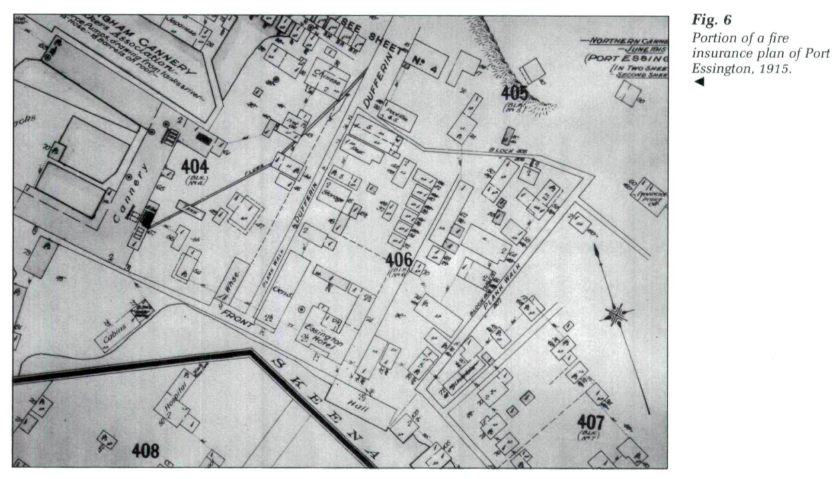Articles
The Industrial Archaeology of the Organization of Work:
A Half Century of Women and Racial Minorities in British Columbia Fish Plants
Abstract
In order to develop an understanding of the nature of the workforce and the organization of work in this seasonal, socially and technologically complex coastal industry, the presentation explores methodological and interpretative issues concerning ways to integrate information on the physical remains of the province's historic fish canning plants and workers' housing with othertypes of documentation.
In the packing plants, work was segregated by gender, age, and race/ethnicity, but the particular tasks assigned to the men and women of various races and ethnic groups varied over time and from region to region, even plant to plant. Since until World War Ⅱ most work was piecework under contract, few employee records were kept or even created. Historic photographs, oral histories, and old fire insurance and construction plans of the sites are critical research tools. The use of these sources will be demonstrated.
Résumé
Pour aider à comprendre la composition de la main-d'œuvre et l'organisation du travail dans cette industrie saisonnière de la côte du Pacifique, aux aspects sociaux et techniques complexes, l'auteure présente, du point de vue de la méthodologie et de l'interprétation, des moyens d'intégrer à d'autres genres de documentation l'information sur les vestiges matériels des anciennes conserveries de poisson de la province et sur les habitations des travailleurs.
Dans les entreprises de traitement du poisson, le travail était divisé selon le sexe, l'âge et la race ou l'appartenance ethnique, mais les tâches particulières assignées aux hommes et aux femmes de divers groupes ethniques et races ont varié selon les époques, les régions et même les usines. Comme le travail était le plus souvent exécuté à la pièce et à contrat jusqu'à la Seconde Guerre mondiale, peu de dossiers d'employés étaient conservés ou même établis. Les photographies historiques, témoignages, anciens contrats d'assurance-incendie et plans de construction sont des outils de recherche d'une importance cruciale, dont l'auteure démontre l'utilisation.
1 This quote is the observation of a passer-by. It underlines the importance of the salmon-canning industry to British Columbia history. And, if we accept that industrial location and industrial landscapes are the outcome of the social and economic integration of space,2 it also raises two fundamental questions. Was there, in fact, no structural or spatial order to these industrial settlements? What did insiders think of these places? This discussion will demonstrate a method for answering these questions.
The Historical Setting
2 Virtually nothing that we know about the history of manufacturing industries, industrial or fishing communities, workers' housing, or gender-segregated and ethnic work forces holds true for the west coast salmon cannery operations and their camp-like villages. With salmon canning we have an industry that until the last few decades did not fall into the category of large, centralized factories that operated year round, were located in urban settings, and drew upon local labour supplies.3
3 A scattering of historic accounts and secondary sources, written mostly by white males, gives us information about various aspects of the industry's development, including valuable glimpses of life and work at the canneries, but not a coherent picture. Until the 1960s, the salmon canneries only operated during the fishing season, and most were located in remote and isolated settings. They housed the fishing fleets as well as a variety of industrial operations. Every one of these tidewater cannery sites depended on water transport. Some canneries operated for only a season or two, while others lasted for 50 or more years, though there were always gaps in their years of operation. Most of the canning sites had been established by the turn of the century, and there occurred a final construction boom between 1914 and 1928. A total of approximately 223 salmon cannery sites were established over the period 1871 to 1971.
4 Mechanization of salmon canning was slow and geographically uneven in British Columbia, even though salmon canneries represented the first factories on the coast and technological changes were available from the late nineteenth century onwards.4 The canneries employed transient, culturally-and racially-mixed work forces of female and male fishermen and shoreworkers. The crews and managers alike lived at the cannery camps during the fishing season, afterwards returning to their home base. The same people did not necessarily return to cannery work or the same canneries each season.
5 We know that cannery work was segregated by gender, age, and race-ethnicity, and the particular tasks assigned to the males and females of various ages, races, and ethnic groups varied over time and from region to region, even plant to plant.5 Until World War II, most work was piecework under contract.
6 All this, however, tells us nothing about the actual physical pattern and social realities oi life and work in the cannery camp-villages. Normally, one could take a conventional industrial/historical archaeological approach to dealing with this problem. But in this case, fieldwork is rather impractical. A recent aerial survey of the sites reveals the reasons.6 For one thing, of the few hundred sites on which canneries operated, only a handful house cannery operations today, and they are not typical. On the abandoned sites, little aboveground evidence remains. Also, because many of the buildings were built over the tidal foreshore, on rocky beaches, or areas that have been largely obliterated by urban sprawl, there is little possibility of productive archaeological excavations at most of these sites.
Methodology
7 There are three lines of evidence which allow us to study aspects of the material expressions of cannery culture: relevant historic photographs, interviews with surviving cannery people, and old fire insurance plans of the sites. Each of these sources contains special details about the social, economic, technological, and spatial aspects of life at the canneries. The utility of these sources is enhanced several fold when analyzed in combination with one another. In particular, they allow us to deal with three critical components that are often missing in traditional sources about industry—the spatial, female, and racial.
 Display large image of Figure 1
Display large image of Figure 18 The fire insurance surveys are the focus of study here. These provide the most plentiful, early, continuous, and comprehensive coverage of all with which to undertake a systematic study. They provide spatial information on all dimensions of life and work at the cannery villages that normally are omitted from other sources.
9 Industrial archaeologists, along with others interested in material culture history, have long appreciated the value of insurance surveys as indispensable historical documents for studying the physical remains of industry.7 Because fire insurance plans were made in an age of high industrialization, and because the insurance companies updated them as changes occurred, the surveys present a unique record of changes to industrial sites, buildings. processes, and social practices overtime. An example of the value of these historical sources for material history is found in a recent study of the celebrated Gooderham and Worts distillery complex in Toronto.8 The business began in 1831. Just before it ceased operation in 1990, it was hailed as the earliest, most intact distillery operation still in use in North America. Due to the absence of company records and family papers, much of the economic, technological, social, and building history of the site has had to be reconstructed almost entirely from a series of fire insurance plans of the site.
10 It was the practice of fire insurance companies to undertake accurate surveys of businesses in the high risk category. Various incendiary features—the highly flammable nature of the materials worked in the manufacturing process, wood frame construction, sources of heat and light, the explosive nature of steam engines and boilers, and the heat produced from power transmission using belts and shafting—made industrial properties special fire risks. The insurance surveys generated two types of records. The first is the inspection report— physical descriptions of the key buildings on the site, including information on use, machinery, and equipment. Rarely have these survived. The second is an accompanying ground plan to scale showing internal and external details, including function, of the premises to he insured and their relative position to neighbouring structures, transportation networks, sources of water and power, housing quarters, and so on. The map or plan is drawn on a large scale (50, 100, or 200 feet to the inch), with a key plan at approximately one-tenth the scale of the detailed sheets. With the aid of colour and symbols, the plans show the size, shape, type of construction materials, and function for each building, and the number of floors, and the location of openings, chimneys, and boilers. In contrast to the inspection reports, the ground plans have survived and are available in major repositories.
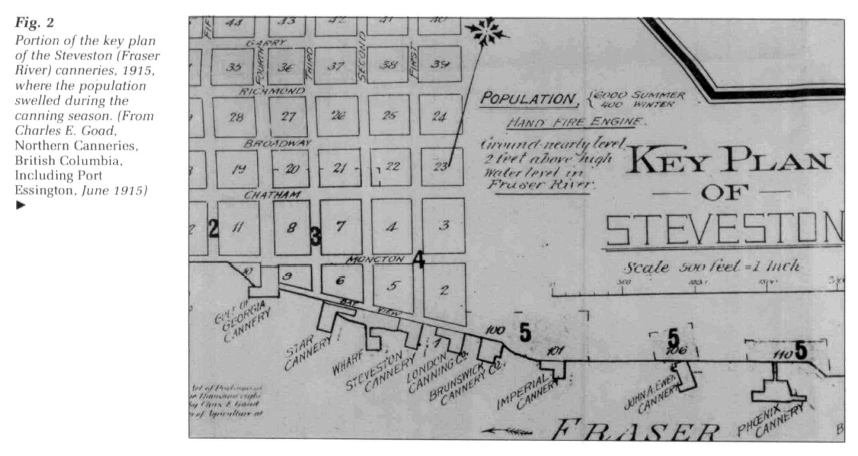 Display large image of Figure 2
Display large image of Figure 211 The historic fire insurance plans (and when they survive, inspection reports), contain a wealth of details about building construction, site layout, processing techniques, the organization of work, materials handling, transportation technology, and social practice at various points in time and across space. The plans are also useful for pinpointing the actual location of individual plants and complexes.9
12 Insurance maps and plans exist for entire towns and cities as single-sheet plans or complete atlases, and these are widely known and used by researchers. Less well-known are the site-specific surveys for individual industrial properties by the insurance industry. In British Columbia, special surveys were undertaken for mining, sawmilling, and salmon canning.10
13 The West Coast salmon-cannery camps were excellent candidates for undertaking special insurance surveys. Because of the methods of making and sealing cans, and cooking canned salmon, and the stores of gasoline and other flammable products at these sites, cannery fires were very common occurrences. Seldom did a year go by when no cannery fires were reported in the local newspapers or annual reports of the provincial fire marshall's office. Given the all-wood construction and remote and isolated settings of most of the cannery camps, cannery fires tended to be particularly destructive. The supply of salmon was available over such a short season that a cannery fire could wipe out a year's worth of profits. These factors added greatly to the risks and costs of operating what already was a precarious business. A newspaper account of the fire at a pioneer cannery on the Skeena, the Inverness, in 1920 illustrates the point:
Because the fire had occurred in April, it was possible to rebuild in time to process the runs of salmon that year.
14 For the occupants of the site, cannery fires must have been terrifying. Ed Sparrow and his family spent several seasons in the inter-war period at Claxton cannery, on the Skeena River. He remembers a fire that occurred there in the late 1930s. Ed war four or five miles away from the cannery, waiting at a fishing camp for the tide to slacken up, when he received word of the fire. He raced that distance back to the cannery, to discover the fire out and the site abandoned. Apparently, the boiler room had caught fire and the possibility that the tank could explode had caused everyone to pack up their belongings and flee for their lives. He searched for hours before finding the rest of the family. Recalls Ed, "The wind was blowing pretty good you know, west wind blowing right from the cannery to our shack. The shacks were lined up. The cannery was way off on the bloody flats...yeah, it started a fire on our roof."12 In this case, the direction of the wind had protected the cannery building but threatened some of the native housing.
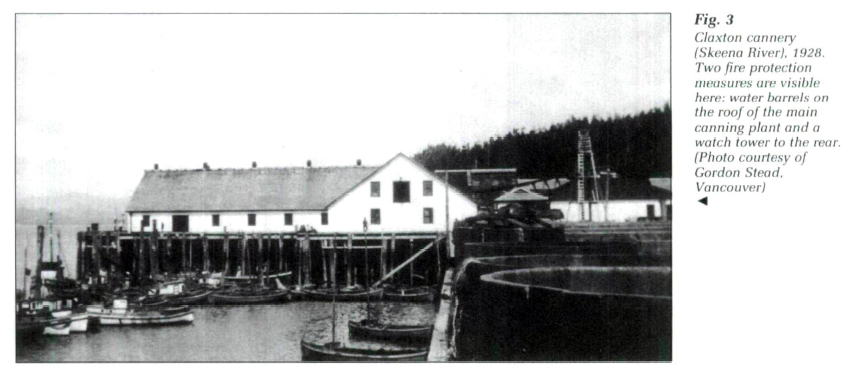 Display large image of Figure 3
Display large image of Figure 3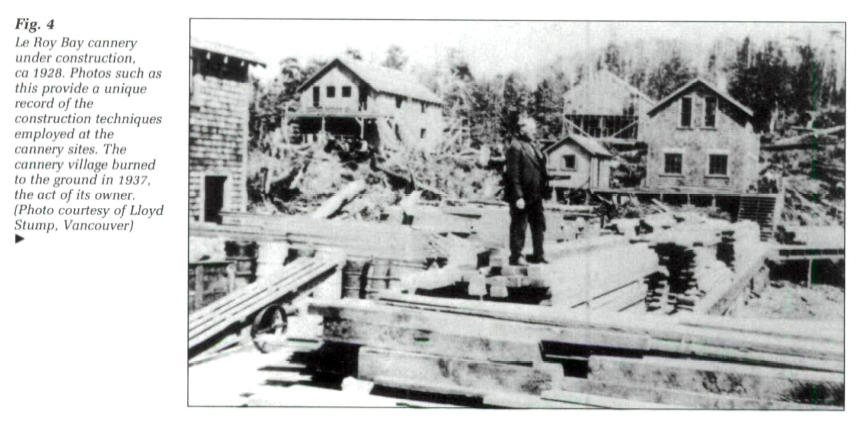 Display large image of Figure 4
Display large image of Figure 415 Small wonder that insurance underwriters paid particular attention to the various cannery operations, undertaking a number of editions of plans for specific districts, such as the Fraser River and Northern districts and of the properties belonging to specific companies. Approximately 320 fire insurance plans and 75 inspection data forms for British Columbia salmon canneries have been uncovered to date. This is an impressive and unusually high number for such a seasonal and relatively marginal industry.13 The salmon-cannery plans relate to 144 of the 225 individual sites (or 64 per cent of the total for the province). In all, they cover a long period of time, from the turn of the century to the 1960s, though they mainly apply to four specific years: 1897, 1911, 1915, and 1923. In those years, a special series on the British Columbia canneries was produced. As already indicated, these were critical years for the industry in terms of geographical expansion, technological change, and shifts in the composition of the work force. Quite a few other fire insurance plans are available, not as collections but as individual items, or in a few instances, as part of urban surveys of the larger communities of which they were a part. Although every district was eventually represented in the plans, the focus was on the most productive districts whore there occurred a concentration of cannery camps: the Fraser River and Northern districts.
16 Inspection reports survive for the special 1923 series (a coast-wide survey) and for the period 1930 to 1960 for Canadian Fishing Company plants only. The reports add crucial details about type and value of plant, equipment, and machinery; processes; ownership; nature, quantity, and regularity of annual productivity; composition of the labour force; and distance of site from the main distribution centres (Vancouver and Prince Rupert) and from the fishing grounds.
The Structure of Cannery Villages
17 A systematic analysis of the insurance plans allows us to make some meaningful generalizations about the cannery sites. First, there were two types of sites, defined in terms of their socio-economic settings: a) those situated in developed areas and, b) those situated in remote settings. The latter were more common. Secondly, virtually all the sites were spatially compact because of foreshore and beach limitations. Thirdly, there was a basic spatial structure, in that sites had the following sectors: industrial, fishing, domestic/community, and administrative. It should in future be possible to re-map cannery sites to reflect the location of these basic activity areas.
18 Each of these sectors, in turn, had its own internal structure. The insurance plans disclose an amazing complexity of buildings that no other type of evidence could give us. And by examining the plans in chronological sequence, it becomes clear that the complexity and diversity of buildings generally increased over time with social and economic changes in the industry, and changes in the labour supply. Taken in total, the cannery camp-villages included over 60 distinct types of buildings other than the main canning plant and dwellings. Included were everything from boat-building sheds and blacksmiths' shops, to cannery stores and offices, customs shed, cold storage filants, coal sheds, and compressor houses, to toilets, saunas, and bathhouses, schools, churches, and fire halls, mess houses, hen houses, pig pens, watchmen's sheds, fish oil reduction works, warehouses, box factories, and can manufacturing plants.
19 From examining the fire insurance plans it becomes clear that the main canning complex was inevitably built over the tidal foreshore on pilings or mud sills. Typically, the service and storage buildings, auxiliary facilities, and cannery store/office were located close to the main canning plant, and therefore to access to the water transport facilities. Not surprisingly, the fuel storage facilities tended, for reason of safety, to be situated well away from both the main packing plant and living areas. An intricate, extensive network of boardwalks connected the cannery and the other activity areas to the housing sites.
20 The various housing quarters, which were always segregated according to race and, where applicable, to occupational status, flanked the main canning complex. Since the Chinese were strictly shoreworkers, the China House was usually, but not always, close to the canning plant. The native, and to a lesser extent, Japanese, housing was more plentiful and varied, and therefore was scattered around the site.
21 Here, we are primarily interested in the domestic sphere. The plans indicate that despite the spatial limitations of the site, ethnic boundaries were maintained in housing. There was spatial segregation of racial groups and a variety of housing accommodation for each of them. Thus, the work force was ethnically mixed, but not intermixed, on the site. As the oral accounts which follow richly describe, ethnic boundaries were maintained both on and off the job.
Cannery Housing
22 Often there was quite extensive and varied housing, especially at the isolated sites away from the Fraser River district, where seldom was off-site housing available. Cannery camp-village dwellings were of many types, ranging from separate or attached houses for the manager and senior staff, to individual cabins for Japanese fishermen and their wives, to multi-storied crowded bunkhouses for the Chinese male contract workers and rows or clusters of "shacks" or "huts" for the native families, most of whose members fished and worked in the canneries.14 In total, the plans disclose 46 different categories of dwellings.
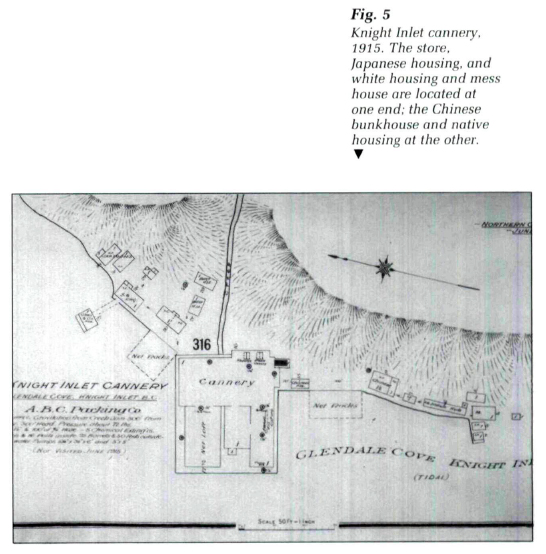 Display large image of Figure 5
Display large image of Figure 523 The China House (alternatively, "Chinese," "Chinese Bunkhouse") sheltered the Chinese contract labour. While at the canneries, the main canning plant and the bunkhouse were their entire world. Because visitors to the China House were numerous, we have some idea about life inside. Tiers of short, narrow shelves, each serving as a bunk for one man, narrow aisles between the tiers, and a mess room made up the cramped interior. At Bones Bay in the 1930s, about 85 Chinese lived in the bunkhouse.15 In the kitchen portion, the Chinese cook fed the crew from enormous woks built into brick fireplaces. At the LeRoy Bay cannery, recalls Lloyd Stump, the Chinese contractor, or "China boss," and his young son lived in a separate compartment in the China House.16 As a small child, Lloyd spent summers at the Stump cannery and often ate in the China house.
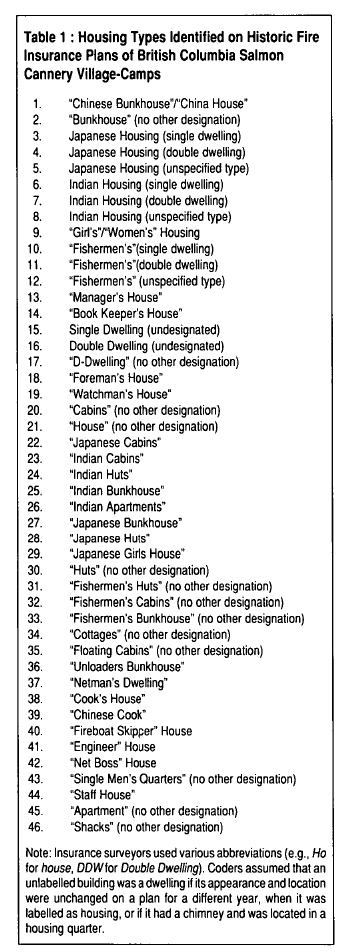 Display large image of Table 1
Display large image of Table 124 Unlike the case of the China house, rarely did anyone other than Japanese visit the Japanese dwellings. After the Japanese were removed from the coast and interned in the winter of 1941-42, the Japanese housing was renamed on the insurance plans to describe the replacement work force—usually "girls," or "Indians." One old cannery worker remembers that the one Japanese dwelling at Bones Bay cannery became a house for Finnish girls (likely from the Finnish settlement at Sointula).17
25 Agnes Alfred ("Axu"), who is another of the old cannery workers, recalls the great variation in native accommodation from one cannery to another.18 At Brunswick cannery, native girls lived in large houses with temporary, semi-partitions separating them. At a neighbouring cannery, Kildala, the native dwellings were divided into four rooms, each of which housed one family, with one common stove in the centre of the building. At Bones Bay cannery, the native housing comprised both individual dwellings and a series of long building complexes, with solid partitions creating individual rooms. At the Knight's Inlet cannery, native families lived in one-room dwellings that were arranged in rows. The same held true at the Wallace cannery camp, Smith's Inlet. Katie Adams recollects that at this cannery, large families got larger shacks; James Henderson remembers that in the early years many of the shacks had neither a floor nor stove.19 Typically, however, canning companies provided every native family with a stove and supply of wood. Seldom was there electricity or indoor plumbing, only coal oil lamps, outdoor privies, and cold water taps. All in all, cannery owners provided natives with crowded, primitive accommodation, but as far as many natives were concerned, their cannery housing was only meant to serve as temporary summer accommodation.20
26 The cannery manager and his staff typically lived further from the main plant than those who worked in it. Gordon Stead, who as a 16-year-old white engineering student at the University of British Columbia worked at Claxton during the summer of 1928, recalls that the prestige living sites at Claxton were on the mountainside, located a distance away from the main canning plant. These were reserved for the manager, the senior staff and, interestingly, Haidas from the Queen Charlotte Islands.21 According to Stead, the Haidas were the best fishermen at the cannery. Next in line were the Norwegians, Japanese and then the "Indians" (by which he simply meant the local natives). At the Bones Bay cannery, the "white girls" lived "up the hill."22
27 Where no ethnic or racial identification for dwellings are given on the fire insurance plans, it is to be assumed that the occupants were "white." The plans indicate that in addition to actual dwellings, portions of industrial and administrative structures, such as the boat building works, mess house, and store/office, also housed a staff member.
28 The cannery housing for natives poses a particularly intriguing research problem. The insurance plans often show several different clusters of "Indian" housing, but give no clue as to the reasons for such arrangements. Only the oral testimonies of former cannery workers, such as the one by Gordon Stead above, provide the answer. Rose Sparrow remembers that Claxton cannery "had the Aiyansh there, Kitkatla, Metlakatla, Port Simpson, Hartley Bays and Greenville, Hazelton. All them people were at the cannery, and it was the biggest camp there." She went on to report:
Rose made a similar observation about the Steveston cannery camps where she worked during and after World War II.24 Behind the Imperial cannery there used to be separate "longhouses," for the natives from Alert Bay, Cape Mudge, and North Vancouver. At Great West cannery, which was much smaller and a bit primitive compared to Imperial, only Kuper Island natives worked. They, too, lived in long, apartment-like buildings, with three to four families living in one very large apartment.
29 The insurance plans fall down, however, on several other counts. Not everyone who worked or fished for the canneries were actually housed on the site. The "cannery row" that developed along the waterfront at Steveston (Fraser River), for example, was supported by a large Japanese population of fishermen and shoreworkers and, to a lesser extent, by Scandinavian fishermen. Most of the Japanese fishermen lived in the fishing centre of Steveston itself. Some Scandinavian fishermen lived in the various tiny fishing communities along the Fraser, such as Finn Slough and South Dyke, while other fishermen simply lived on their boats throughout the fishing season.25 Thus, the presence of "Indian" housing and the absence of non-native housing on the fire insurance plans of the Steveston canneries could prove misleading. The same holds true for Port Essington, on the Skeena River.
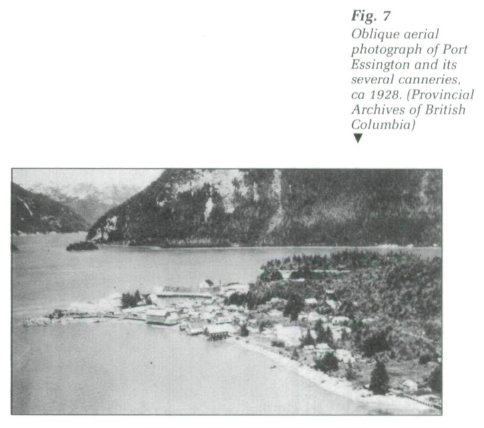 Display large image of Figure 7
Display large image of Figure 730 On the other hand, some people lived on the site in dwellings that, because of their temporariness, would not have been recorded on the insurance plans. Natives in the early period often pitched temporary camps at the canneries. Later on, some native families lived at the cannery camps in their own floating houses (known as "floats"). Ann Brochie, whose family worked at the Bones Bay cannery in the 1940s, says that her family lived in their own house on floats because the cannery houses were too small. Eventually the canning company built a two-storeyed house in the native quarters, so her family moved into that.26 In any event, neither tents nor floats would have appeared on fire insurance plans.27
31 Even when the insurance plans are relatively comprehensive, oral testimonies provide unique details about informal domestic arrangements. At Port Edward, Skeena River, village life was centred around the cannery. Hazel Stewart grew up there. In her words,
Similarly, only by tapping living memories do we know that at Claxton cannery, the old Mission House that had stood on the site even before the cannery was built was used as a rooming house for white workers. They, and most of the other white workers and staff, ate in the mess of the official white bunkhouse.29
Material Lives
32 From oral histories and historic photographs we find out more about the material lives of native women than the insurance plans could begin to reveal. We gain a sense, for example, about how they used the space around them, and how they linked their domestic life to their cannery work.30 Katie Adams said that every cannery had some place where you could go to dance on the weekend. That place usually was the cannery loft, though at Bones Bay in the 1940s there was a recreation hall.31 The young natives went to the Saturday night dance even if they were working late, and no matter how tired they were. The day World War Ⅱ ended, she and the other Bones Bay cannery workers laboured for 16 hours straight, after which they all went to the "rec hall" for a dance.
 Display large image of Figure 8
Display large image of Figure 833 Sundays and Mondays were the days of the week when there would be no salmon to process because of the government-imposed ban on salmon fishing for two days each week. It was on these days that the laundry, berry picking, and other domestic chores would get done. After the war, the manager at Bones Bay sometimes permitted the native women cannery workers at the end of a day to can salmon caught for their own consumption.32 According to Katie Adams, natives also had their own smoke-houses for preserving their own supply offish. These appear on fire insurance plans as tiny buildings located near the native housing quarters and occasionally are identified as such.
34 Thousands of children were born at the canneries. The native people had midwives; each cannery village had its own.33 In the early years of this century, Florence Edenshaw, of Masset, Queen Charlotte Islands, accompanied her parents to a cannery in southeastern Alaska, where her mother gave birth to her last child. Florence, who was only six at the time, spent that and the next three summers at the cannery camp, babysitting her younger sisters.34 Rose Sparrow had a third child at Claxton cannery in the 1920s.35 She worked right up to the last hour, went home to give birth a few hours later, stayed home one week, then returned to work on the canning line. Her eldest daughter, who was 12, babysat. Later, when the Sparrow family shifted back to the Fraser, Rose's husband Ed began fishing for Brunswick cannery and the family lived on the site. She had a new baby, and with her other children in school, she had no one to look after it.36
35 It was not uncommon for cannery owners to provide nursery services, especially when competition for native labour was high. Hazel Stewart recalls her own mother's experience:
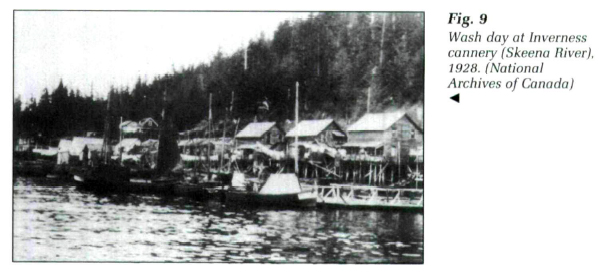 Display large image of Figure 9
Display large image of Figure 936 Girls who were not needed for babysitting apprenticed in the canneries or the net lofts with their female relatives. In the early years, native girls started very young. Elizabeth Spalding of the Skeena River area recalled beginning to work at the age of 8:
Katie Adams was six or seven years old when she first worked at a salmon cannery; her first cannery job was to fill trays with empty cans that would then be passed along to the women who filled the cans with pieces of salmon.39 Other tasks commonly undertaken by small children were lacquering and labelling the cans after they had been filled, sealed, and cooked.
37 By the 1920s, children under the age of 16 were no longer officially hired, but interviews reveal that 13- and 14-year-old girls lied to the cannery managers about their ages, though given the close nature of the "canning community," it is difficult to believe that anyone was fooled.40 Ann Brochie and Lucy Smith began work on the Bones Bay cannery line when they were 12 and 13 respectively, in about 1942.41 Ann's mother said Ann could go to work as long as she stood between her mother and an elderly woman. As far as Ann knew, at that time there was no such thing as being too young to work. From this interview and others one has the impression that underage workers were routinely employed by canners during World War Ⅱ, when labour shortages were high and the wartime demand for canned salmon virtually unlimited.42
Conclusion
38 To date, industrial archaeological studies of workers' housing have focused on physical remains, and on the housing of an ethnically homogeneous work force that lived in permanent, mainly urban, communities.43 For this study of the historic salmon cannery sites, different methods have had to be developed. Fire insurance surveys tell us that most of the sites were seasonal, and limited in size. Also, the cannery villages were racially and culturally mixed, but strictly segregated. Oral testimony and historic photographs reinforce these impressions and give us a feel for what those attributes meant in human terms from the perspective of the native women and others who worked there. Moreover, these sources help us to understand why some of these traits persisted.
 Display large image of Figure 10
Display large image of Figure 10 Display large image of Figure 11
Display large image of Figure 11